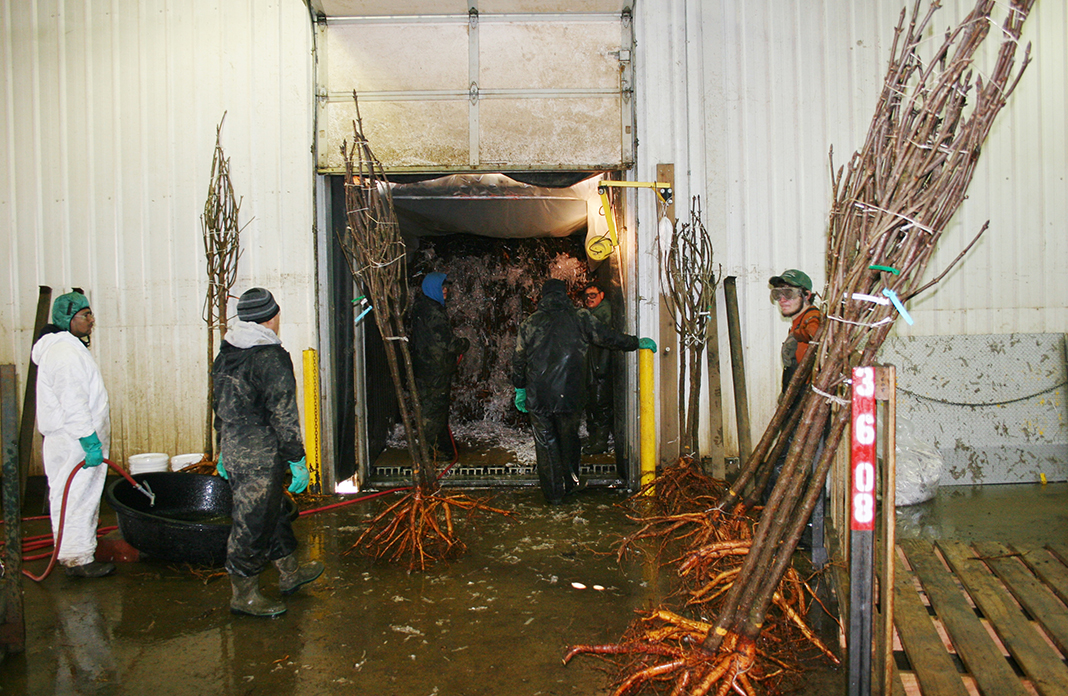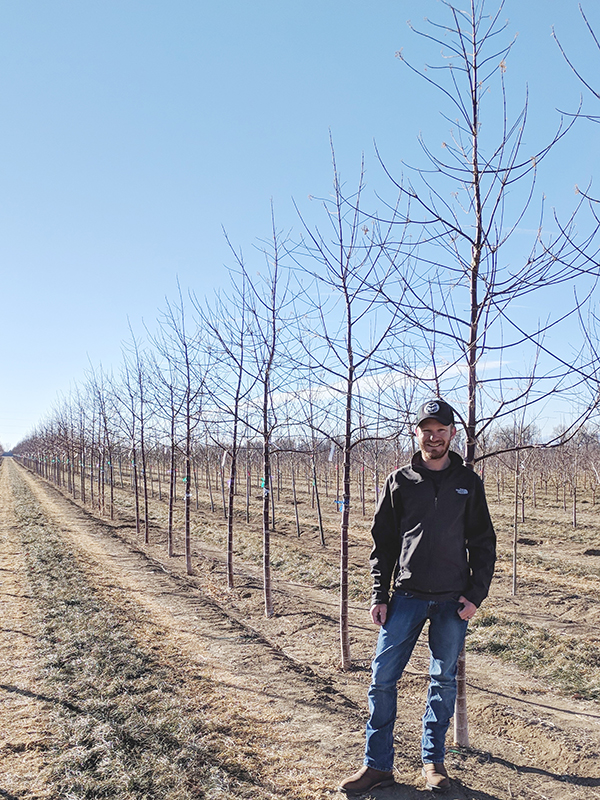From selecting and storing to pruning and planting, each step in caring for bare root liners is critical for their future growth into healthy, thriving plants. Whether bare root shrubs and trees are destined to be grown in the ground or containers, most of the same principles apply to how they are maintained before and during placement in the soil.
Growers should start with selecting bare root suppliers “that will stand behind their products and help you if there is a problem,” said Alameda Wholesale Nursery Delivered Sales Manager Steve Brown, CCNP. “Even the best suppliers have problems, from digging too late or early or storing the product at the wrong temperature or wrong moisture level. Those are beyond your control, but selecting a good supplier will protect you in the long run.”
Upon arrival, bare root stock should be stored in a cool and damp location, away from extreme heat or cold and direct sunlight. After that, proper pruning, planting, and watering are necessary for good results.
“The biggest problem with new bare root not surviving is over-pruning of the root system and continued heavy watering,” said Alameda’s Production Manager Bob Mudra. “The most important part of planting bare root is to not plant them too deep, which will kill a bare root plant.”
Boxelder Tree Farm Field Production Manager Brad Meyer also lists proper planting depth as one of the top three concerns that affect success with bare root. To ensure plants are in the soil at the right point of the trunk, he recommends checking within a couple days of planting and making adjustments as necessary.
Proper pruning is also in the top three, especially making sure to balance the roots and the tops of the plants. “I learned in school that you should not prune the tops at all, because when you do the plant produces gibberellins, which promote top growth. Science shows not to prune at planting, but if you don’t prune the top, you have other problems,” Meyer said. “That’s always been a point of contention between nursery professionals and academia. You can’t have those big, long, heavy tops when the tree is not rooted out yet.”
And his third, but most important way of ensuring success with bare root is selecting a good quality liner. Starting with a liner from a supplier that focuses on producing the healthiest bare root is key. One of Boxelder’s suppliers is Carlton Plants of Oregon, which “pioneered the idea of starch testing trees before digging them (a process that determines the amount of sugar-starch content in the root systems’ cambium layers to indicate whether a plant is dormant enough to be harvested). The plants are healthier in the spring, and very strong in leafing out,” said Meyer, adding that Carlton’s other production practices like undercutting and refrigerated storage likely add to the high quality as well.
“A lot of times you can pay less to get a B grade or less quality liner, but that money you save at the beginning is lost later on correcting flaws in the plant,” he concluded.
How to Select, Store, Prune, and Plant Bare Root
Selecting a quality liner
- Purchase from a reputable grower with proven quality that will guarantee its products and provide support if there is a problem.
- Pick the liner based on sizes that work for your production style, with a good root ball, branching and structure. [Boxelder Tree Farm starts all its ornamentals with six-foot branched liners, and all its shade trees with six to seven foot whips. Whips allow the grower to determine where scaffold branches will eventually be set.]
 Storing properly
Storing properly
The main goal in storage is to keep the plants as dormant as possible until they go into the field. If plants start pushing leaf, they are starting to take moisture from the roots up to the top, which shouldn’t happen before they are in the ground. Anything starting to break bud needs to get out quickly to prevent elongated growth.
Cool temperature
- Store in a closed building away from direct sunlight.
- Keep the air temperature between 36 and 55 degrees Fahrenheit—the low 40s is optimal.
- Refrigerate the building or use a refrigerator trailer equipped with irrigation if possible.
- When refrigeration is not available, store in an insulated building (ensuring that insulation has a waterproof covering). Opening up the building at night helps to bring in cool air that can then be trapped inside during the day to help maintain lower temperatures.
- Don’t assume the refrigeration is on or that indoor temperatures are cool—check temperatures at least once a day to ensure temperatures are adequate to avoid heat damage or plants going into bud too early. If a tree has leafed out before it is planted in early spring, it is more likely an early frost could kill the immature leaves.
- Clean out the storage area each spring and make sure the air conditioner works.
High humidity
- Install, maintain, and utilize a misting system with a timer to use day and night or as necessary, even in combination with hand-watering, depending on the conditions. [Meyer of Boxelder said little water droplets hanging off the plants is a sign that he is watering sufficiently.]
- For plants with heavy roots and less hair roots, provide more moisture to keep them from drying out.
Limited storage
- Store for 10 days or less if in a warmer temperature range of 45 to 55 degrees.
- Store up to three weeks if in refrigeration (36 to 44 degrees).
 Pruning
Pruning
Roots
- Take off as little of the root as possible since it is the food source for the plant.
- Remove any broken roots.
- Cut an inch from the tips of each root where it has dried out, trying not to cut good, healthier root tissue.
- Trim roots to fit the size of the containers (keeping in mind the goal of minimal pruning).
- Cut back large, less fibrous root systems like bare root peach trees.
Tops
- Pick quality tree liners that are not really leggy, so not a lot of branch pruning is necessary. However, all ornamentals including quality ones come in branched and need trimming.
- Always try to prune before the buds break—trimming after leafing out wastes the tree’s energy.
- Remove broken branches as much as possible.
- Cut so buds will grow away from the tree trunk, not in all directions.
- Prune the top to balance it with the root system and to the caliper of the trunk. Leaving too much on can make the top too heavy and cause the plant to bend or fall over. [Boxelder tops all its seven to eight-foot whips by about a foot. Alameda cuts back shrubs that are going into #5 containers to a minimum of two feet tall.]
- Cut back Spirea and Potentilla to remove the spent flowers.
- Do not cut back plants like lilac with terminal buds.
- Thin out and cut back peach tree branches to help them break bud and leaf out.
- After budding, use masking tape to hold them straight.
Timing
- Prune just before planting (within minutes if possible).
- Pruning inside a building can be easier in bad weather, but there is risk of the plants drying out before they get in the field.
 Planting
Planting
Fertilizing
- Apply fertilizer directly to the soil before planting as an inexpensive step that can increase plant health. [Boxelder uses a 0/10/10 (nitrogen/phosphorus/potassium) fertilizer applied in a ditch and then drills holes for the trees, which mixes in the fertilizer well. Alameda incorporates 200 pounds of a slow-release 19-5-8 fertilizer per 60 yards of soil.]
Depth
- When planting in a field, try to get the holes to coincide as closely as possible with the depth of the roots.
- Plant bare root with the top of the root within the top two inches of soil, or at least with the crown (grass line) at or just above the final soil level. Planting too deep will kill a bare root plant.
- Work the soil around the root system.
- If necessary, top with more soil after a complete and thorough watering, but do not cover the crown of the plant.
Watering
- Water thoroughly right after planting and then as necessary depending on the climate and weather.
- Keep the plants pretty wet until they start to leaf out, or if preferred, water on a wet-dry cycle where they don’t get too dry, but are also not saturated all of the time.
- Bear in mind that overwatering can cause root rot of new bare root plants.
Post-planting adjustments
- After the first watering, go back through the plants to make sure the depths are correct. If needed, put more dirt in or pull the tree up.
- During the second watering, straighten any trees that have settled crooked or been blown over at all by the wind. Avoiding planting in strong winds will decrease this possibility.
- Try to avoid planting during a period of high temperatures, which can dry out new bare root plant tops before they can bud and leaf out. If temperatures are high, ensure plants are sufficiently watered.










